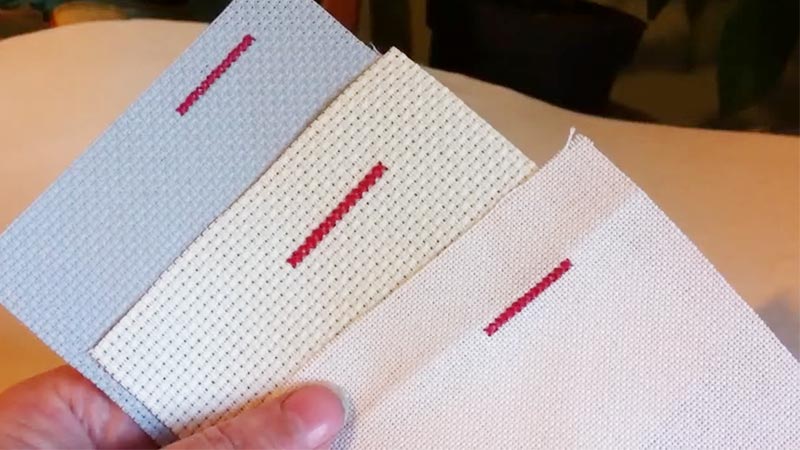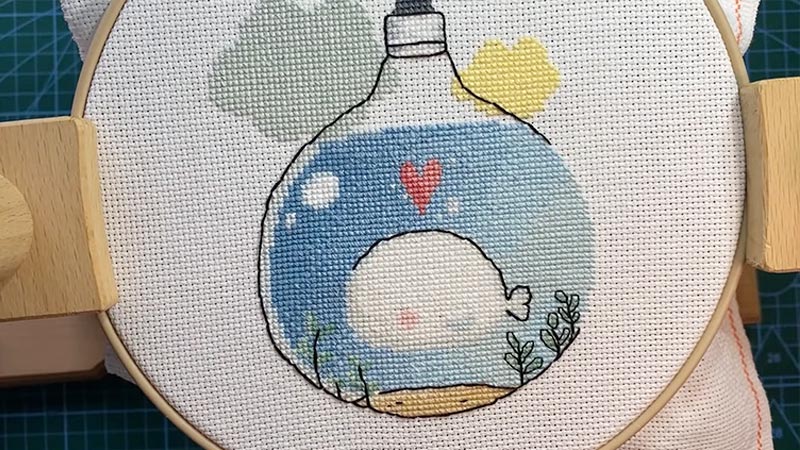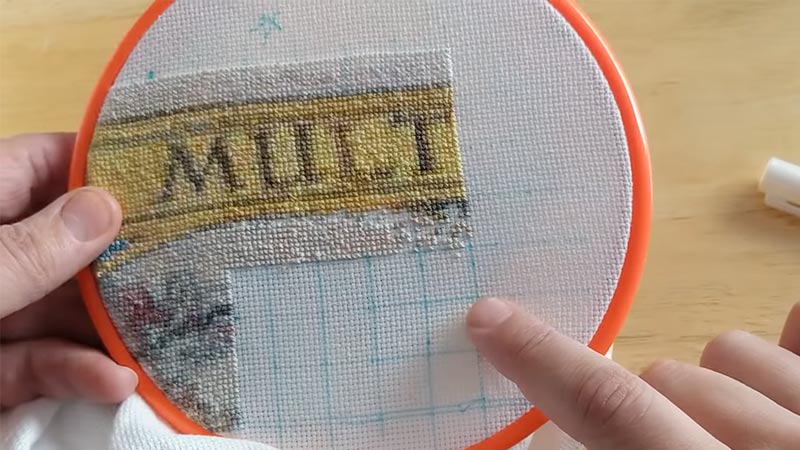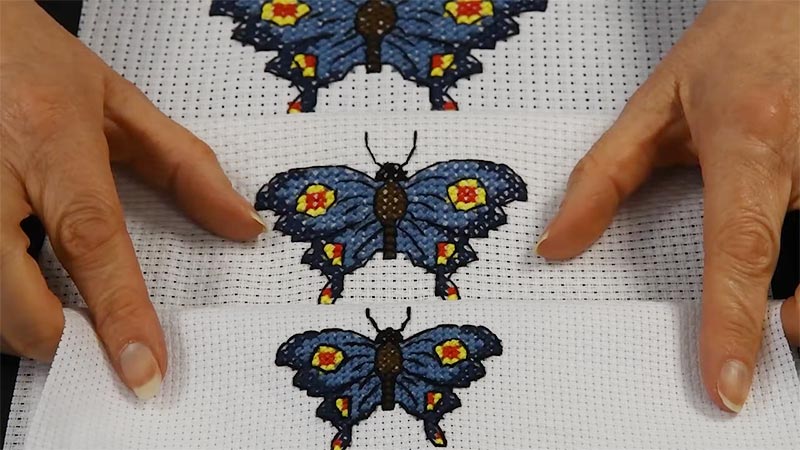In the intricate world of cross-stitching, the term HPI holds paramount significance. HPI, an abbreviation for “Holes Per Inch,” serves as a fundamental metric that defines the very essence of cross-stitch projects.
It is a numeric representation of the number of fabric threads woven into a square inch of the cross-stitch fabric.
This seemingly technical detail profoundly influences the appearance, level of detail, and overall quality of the final piece.
HPI acts as a bridge between imagination and execution, dictating the fabric’s texture, and the size of stitches, and ultimately determining the success of a cross stitch project.
Understanding the essence of HPI is key to creating beautifully crafted, visually captivating cross-stitch artworks.

What Does HPI Mean in Cross Stitch?
In cross stitch, HPI stands for “Holes Per Inch,” and it is a crucial metric used to describe the fabric’s count or density.
Cross stitch is a form of needlework where X-shaped stitches are used to create intricate and colorful designs on fabric.
The choice of fabric is an essential aspect of cross-stitching, and HPI is one of the key factors to consider when selecting the right material for your project.
HPI, or holes per inch, refers to the number of holes or squares present in one linear inch of the fabric.
The fabric is typically woven or manufactured in a way that creates a grid of tiny squares or holes. The HPI count is essential because it determines the size and level of detail you can achieve in your cross-stitch design.
Higher HPI values mean more holes per inch, resulting in a finer and more detailed finished piece, whereas lower HPI values yield a larger, coarser design.
Why HPI Matters in Cross Stitch?

HPI, or “Holes Per Inch,” is a crucial aspect of cross-stitching that greatly impacts the final look and quality of the finished piece.
It refers to the number of fabric threads per inch in the fabric used for cross-stitching, and it’s an essential consideration for any cross-stitch project.
Here are several reasons why HPI matters in crossstitch:
Detail and Precision
The HPI of the fabric determines the level of detail you can achieve in your cross-stitch design. Higher HPI fabrics have more threads per inch, allowing for finer and more intricate stitching. Lower HPI fabrics are better suited for larger, more simplified designs.
Design Compatibility
Different cross-stitch patterns and designs are best suited for specific HPIs. Some patterns are designed for 14-count Aida fabric, while others work better on 18-count evenweave or 28-count linen.
Using the recommended HPI for a pattern ensures that the design will be proportional and visually pleasing.
Fabric Appearance
HPI affects the overall appearance of the fabric and the finished piece. Lower HPI fabrics will have larger visible holes between the stitches, while higher HPI fabrics result in a more solid and uniform appearance.
Fabric Strength and Durability
The choice of HPI also influences the fabric’s strength and durability. Fabrics with higher HPI are generally finer and may be more delicate, while lower HPI fabrics are more robust. The selection of fabric should align with the intended use of the finished piece, such as framing or functional items like pillows.
Floss and Thread Choice
The HPI you select should also consider the thickness of the embroidery floss or thread you plan to use.
Thicker threads are more suited to lower HPI fabrics, as they fill the holes more easily, while thinner threads are ideal for higher HPI fabrics.
The combination of HPI and thread thickness affects the texture and visual impact of the design.
Personal Preference
HPI can also come down to personal preference. Some stitchers enjoy the look and feel of working on higher HPI fabrics because they produce a more refined finish.
Others prefer the ease and speed of stitching on lower HPI fabrics, which can make the process more enjoyable for some individuals.
Cross Stitch Counting
Counting the fabric threads to determine where to place your stitches is a fundamental aspect of cross-stitching.
The HPI influences how closely together these holes are, and this can affect the ease or difficulty of counting and stitching accurately.
Availability and Cost
The choice of HPI fabric can be influenced by practical considerations such as availability and cost.
Common HPIs are often more readily available and may be less expensive, which can be a significant factor in choosing the right fabric for your project.
How does HPI Affect Cross Stitch Projects?

Holes Per Inch (HPI) plays a significant role in cross-stitch projects, and it affects them in several ways.
Here are the ways that HPI affects cross-stitch projects:
Level of Detail
HPI determines the level of detail you can achieve in your cross stitch project. Higher HPI fabrics have more threads per inch, which allows for finer, more intricate stitching.
This is ideal for intricate designs, portraits, and small lettering. Lower HPI fabrics are better suited for larger, simpler designs where fine detail is less critical.
Size of the Finished Piece
HPI affects the overall size of your finished cross stitch project. Higher HPI fabrics create smaller, more compact designs, while lower HPI fabrics produce larger, more spaced-out designs. This is important for ensuring that your project fits within the desired frame or display area.
Thread Thickness
The choice of HPI also influences the thickness of the threads you use. Higher HPI fabrics require thinner threads to fill the smaller holes adequately, while lower HPI fabrics can accommodate thicker threads.
Using the wrong combination of thread thickness and HPI can result in a mismatched or unattractive finished project.
Fabric Texture
HPI affects the texture and appearance of the fabric in your cross stitch. Higher HPI fabrics result in a smoother, more solid appearance because the stitches cover more of the fabric’s surface.
Lower HPI fabrics have larger visible holes between stitches, which can create a more textured or rustic look.
Ease of Stitching
HPI can impact the ease of stitching. Higher HPI fabrics tend to require more precision and may be more challenging for beginners.
Lower HPI fabrics are often more forgiving, as the holes are more prominent, making it easier to insert the needle accurately.
Pattern Compatibility
Cross-stitch patterns are often designed with a specific HPI in mind. It’s essential to use the recommended HPI for a pattern to ensure that the design comes out proportionate and visually appealing.
Personal Preference
Ultimately, HPI can be a matter of personal preference. Some cross stitch enthusiasts prefer the refined look of higher HPI fabrics, while others enjoy the quicker progress and larger stitches associated with lower HPI fabrics.
Your preference may also depend on your comfort level and experience with cross-stitching.
Fabric Durability
HPI can also influence the durability of your cross stitch project. Higher HPI fabrics are typically finer and more delicate, while lower HPI fabrics are more robust.
Consider the project’s intended use; if it’s a functional item like a pillow, you might prefer a lower HPI fabric for added strength.
Different HPI Counts and How They Look On Fabric

Holes Per Inch (HPI) in cross stitch refers to the number of fabric threads per inch in the fabric you’re stitching on. The choice of HPI significantly impacts the appearance of your cross stitch project.
Here’s an overview of different HPI counts and how they look on fabric:
14-Count Aida
14-count Aida fabric is one of the most popular choices for cross stitch projects. It has 14 threads per inch, making it easy to work with, especially for beginners.
The holes are relatively large, resulting in a visible grid pattern. It’s ideal for larger, less detailed designs.
16-Count Aida
This fabric has 16 threads per inch, providing a more refined look compared to 14-count Aida. It’s suitable for a wide range of projects, including those with moderate levels of detail.
18-Count Aida
18-count Aida fabric has even smaller holes, resulting in a finer appearance. It’s excellent for intricate designs and smaller stitches, giving your project a more delicate and detailed look.
28-Count Evenweave
Evenweave fabrics, like 28-count, have a similar HPI to 14-count Aida but are woven differently.
They provide a smoother and more refined surface, allowing for intricate detailing. These fabrics are often used for more advanced and detailed cross-stitch patterns.
32-Count Linen
Linen fabrics have a unique texture and appearance. A 32-count linen offers a high level of detail and a vintage, textured look. It’s excellent for complex designs and decorative pieces.
40-Count Linen
40-count linen is even finer, offering exceptional detail and a refined, antique look. This fabric is perfect for highly intricate and delicate projects, such as samplers and heirloom pieces.
Higher Counts
Some even higher HPI counts, like 56 or 60-count linen, are available for extremely detailed and miniature work.
These fabrics create exceptionally fine, museum-quality pieces but require a high level of skill and patience.
How to Choose the Right HPI Count for Your Project?

Choosing the right HPI (Holes Per Inch) count for your cross stitch project is crucial, as it greatly impacts the final look and quality of your work.
Here’s a step-by-step guide to help you choose the appropriate HPI count for your project:
Consider Your Design
Evaluate the cross stitch pattern you plan to use. Patterns often come with a recommended HPI count or fabric type. This can be a helpful starting point, especially for beginners.
Determine Project Size
Consider the size of your finished project. If you’re working on a smaller project like a greeting card or ornament, you may want to choose a higher HPI count to achieve fine detail. For larger pieces, a lower HPI may be more appropriate.
Think About Detail Level
Assess the level of detail in your pattern. Highly detailed designs often benefit from higher HPI counts, as they allow for finer stitches. Conversely, simpler, more abstract designs may be suitable for lower HPI fabrics.
Fabric Texture and Look
Consider the texture and appearance you want to achieve. Aida fabrics, with their easily distinguishable holes, can give a more rustic look, while even weave and linen fabrics offer a smoother, more refined appearance.
Skill Level
Your experience level in cross-stitching is essential. If you’re a beginner, you may find it easier to work on lower HPI fabrics as the holes are larger and more forgiving. Experienced stitchers may enjoy the challenge of higher HPI fabrics for intricate designs.
Lighting and Eyesight
Your working environment and eyesight are crucial factors. If you work in low-light conditions or have poor eyesight, you may prefer a lower HPI fabric for ease of stitching. Higher HPI fabrics may require better lighting and sharper eyes.
The function of the Finished Piece
Consider the intended use of your cross stitch. If it’s for framing or display, you have more flexibility in choosing the HPI.
For functional items like pillows or tablecloths, durability might be more critical, favoring lower HPI fabrics.
Experiment and Sample
If you’re unsure about the right HPI, it’s a good idea to create a small sample with a few stitches on different fabric types and HPI counts. This allows you to see how your chosen threads and stitches look on the fabric.
Consult with Experts
If you’re still uncertain, seek advice from fellow cross-stitch enthusiasts, join online forums, or consult with local craft stores. Experienced stitchers can provide valuable insights and recommendations.
Personal Preference:
Ultimately, your personal preference matters. Some stitchers prefer the look and feel of a particular HPI, and your enjoyment of the process is crucial. Choose the HPI that resonates with your style and vision for your project.
Tips for Working With Different HPI

Working with different HPI (Holes Per Inch) counts in cross stitch requires some adjustments and considerations to ensure a successful and visually pleasing project.
Here are some tips for working with various HPI counts:
Use the Right Thread Thickness
Match the thread thickness to the HPI count. Thicker threads work better on lower HPI fabrics, while thinner threads are suitable for higher HPI fabrics.
Using the appropriate thread ensures even coverage without making the stitches too bulky or sparse.
Mind Your Needles
Choose the right needle size based on your fabric and thread. For higher HPI fabrics, select a finer needle to prevent splitting threads.
For lower HPI fabrics, opt for a slightly larger needle to avoid forcing the needle through tight holes.
Consider Stitch Count
Adjust your design by considering the stitch count required for the HPI. Higher HPIs demand more stitches per inch for a detailed look, while lower HPIs may require fewer stitches.
Account for Fabric Texture
Different HPI fabrics have varying textures. Aida fabrics have clear holes, while even weave and linen have a smoother texture. Adapt your stitching technique to account for these differences in texture.
Lighting and Magnification
When working on higher HPI fabrics with finer details, ensure you have adequate lighting and consider using magnification tools, such as a magnifying lamp or a magnifying glass, to make your work more comfortable.
Stitching Tension
Maintain consistent tension while stitching to ensure that your stitches lie flat and evenly. For higher HPI fabrics, stitches may be tighter, so practice even tension for neat results.
Counting Stitches
When working on higher HPI fabrics, counting stitches can be more challenging due to the smaller holes.
Consider using a highlighter to mark off stitches as you complete them, or use a gridded fabric or fabric marker to make counting easier.
Experiment and Practice
Before starting your main project, practice on a scrap piece of fabric with the same HPI count to get a feel for how your chosen threads and stitches work with the fabric.
Be Patient
Working on higher HPI fabrics can be slower due to the level of detail and precision required. Patience is key, especially if you’re new to cross-stitching on finer fabrics.
Frame and Display Carefully
When framing or displaying your finished piece, choose a method that complements the fabric’s texture. Mats and frames can accentuate the visual appeal of the project.
Check the Pattern Recommendations
If you’re using a cross-stitch pattern, check if it includes specific recommendations for HPI and follow them for the best results.
FAQS
Is HPI the same as thread count in cross-stitch fabric?
No, HPI (Holes Per Inch) refers to the number of fabric threads per inch, while thread count typically refers to the number of threads in a skein of embroidery floss. HPI defines the fabric’s weave, while thread count pertains to the thread itself.
How does HPI affect the reverse side of a cross-stitch piece?
HPI can impact the appearance of the reverse side of your cross stitch. Higher HPI fabrics may result in a neater reverse side due to the closer stitching, while lower HPI fabrics may have a more open and visible reverse side.
Can I use different HPI fabrics in the same cross stitch project?
It’s possible to use different HPI fabrics in a single project, but it requires careful planning. Ensure that the fabric types are compatible, and transitions between them are strategically placed to maintain a cohesive look.
Are there specific HPI counts recommended for specific cross-stitch techniques like Blackwork or Hardanger?
Yes, certain embroidery techniques like blackwork or Hardanger may have preferred HPI counts.
These techniques often rely on even weave or linen fabrics with specific HPI counts to achieve the desired results.
How can I adjust my stitching technique for different HPI counts?
To adjust your technique for different HPI counts, you might need to modify the tightness of your stitches.
For higher HPI fabrics, use smaller, tighter stitches, while for lower HPI fabrics, opt for slightly larger and looser stitches to fill the holes adequately.
To Recap
In the intricate realm of cross stitching, HPI, or Holes Per Inch, is a fundamental metric that dictates the very essence of a project.
It signifies the number of fabric threads woven into a square inch, impacting the level of detail, size, and overall appearance of the final piece.
The choice of HPI is an artistic decision that bridges creativity and execution, demanding careful consideration.
From the rustic charm of lower HPI Aida to the exquisite intricacy of higher HPI linens, it is HPI that shapes the canvas of a cross-stitch masterpiece.
Understanding its significance empowers stitchers to embark on a creative journey that marries precision with imagination.
Leave a Reply